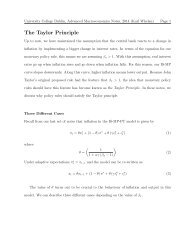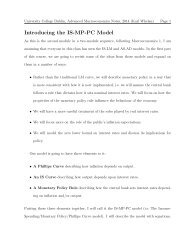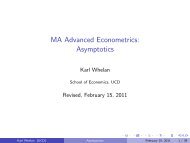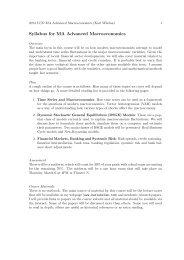ELA, Promissory Notes and All That: The Fiscal Costs ... - Karl Whelan
ELA, Promissory Notes and All That: The Fiscal Costs ... - Karl Whelan
ELA, Promissory Notes and All That: The Fiscal Costs ... - Karl Whelan
Create successful ePaper yourself
Turn your PDF publications into a flip-book with our unique Google optimized e-Paper software.
<strong>The</strong> Eurosystem’s repurchase agreements involve banks pledging financial assets to their local NCB<br />
as collateral in return for loans, with the terms of these loans set by the ECB’s Governing Council.<br />
Haircuts are applied to the collateral, meaning the amount that is loaned to the borrowing bank is<br />
less than the value of the asset, with the amount that can be loaned increasing with the quality of<br />
the collateral. 2 Should a bank default on its loans from an NCB, the collateral framework is intended<br />
to see the NCB still left with an asset that has at least the same value as the loan.<br />
<strong>That</strong> said, no risk-control framework can completely rule out losses on monetary operations. <strong>The</strong><br />
legal statute governing the Eurosystem is quite vague about the implications for an NCB of losses<br />
incurred in monetary operations. However, in practice, the Governing Council of the ECB used the<br />
defaults by Lehmans <strong>and</strong> other banks in 2008 to clarify in a statement in March 2009 that losses<br />
should be shared in full by the Eurosystem NCBs in proportion to their ECB capital key shares. 3<br />
This raises the question of what would happen should a Eurosystem central bank have its capital<br />
eliminated by losses on operations. Perhaps surprisingly, as far as I can tell, the legal structures<br />
underpinning the Eurosystem don’t discuss this eventuality. However, it is generally understood that<br />
NCBs would need to be “recapitalised” by fiscal transfers from their national government.<br />
3.2. <strong>ELA</strong> <strong>and</strong> the ECB Governing Council<br />
<strong>The</strong> Eurosystem allows for a broad range of assets to be pledged as collateral in its refinancing<br />
operations. However, Anglo Irish Bank began to run out of eligible collateral in early 2010 <strong>and</strong> would<br />
have defaulted on bonds or failed to honour deposit withdrawals without access to alternative<br />
funding. <strong>That</strong> funding took the form of <strong>ELA</strong> loans from the Central Bank of Irel<strong>and</strong>. <strong>The</strong>se loans are<br />
provided against collateral or commitments that are not accepted in st<strong>and</strong>ard Eurosystem<br />
operations <strong>and</strong> any losses on these loans fall directly on the ECB, i.e. the usual loss-sharing<br />
arrangements are not applied if a bank fails to repay <strong>ELA</strong>.<br />
<strong>The</strong> Central Bank’s power to issue <strong>ELA</strong> comes from Irish law. <strong>The</strong> Central Bank Act provides it with a<br />
general power to lend against security to credit institutions <strong>and</strong> also provides it with an explicit<br />
financial stability objective which can justify exceptional loans to prevent banks from failing.<br />
This does not mean, however, that the Central Bank has complete freedom to operate its <strong>ELA</strong><br />
programs however it wishes. <strong>The</strong> Eurosystem has reporting procedures in place for <strong>ELA</strong> so the ECB<br />
can assess the effect of these operations on aggregate liquidity in the Euro area <strong>and</strong> the ECB has<br />
substantial control over the activities of NCBs. 4 Article 14.3 of Protocol on the Statute of the<br />
European System of Central Banks <strong>and</strong> of the European Central Bank states that NCBs “shall act in<br />
accordance with the guidelines <strong>and</strong> instructions of the ECB” while Article 14.4 states “National<br />
central banks may perform functions other than those specified in this Statute unless the Governing<br />
Council finds, by a majority of two thirds of the votes cast, that these interfere with the objectives<br />
<strong>and</strong> tasks of the ESCB.” 5<br />
2<br />
See European Central Bank (2011) for a detailed discussion of the operational framework for monetary policy<br />
in the Euro area.<br />
3<br />
See press release here www.ecb.int/press/pr/date/2009/html/pr090305_2.en.html.<br />
4 See ECB (2007).<br />
5 See www.ecb.int/ecb/legal/pdf/en_statute_2.pdf<br />
5

















